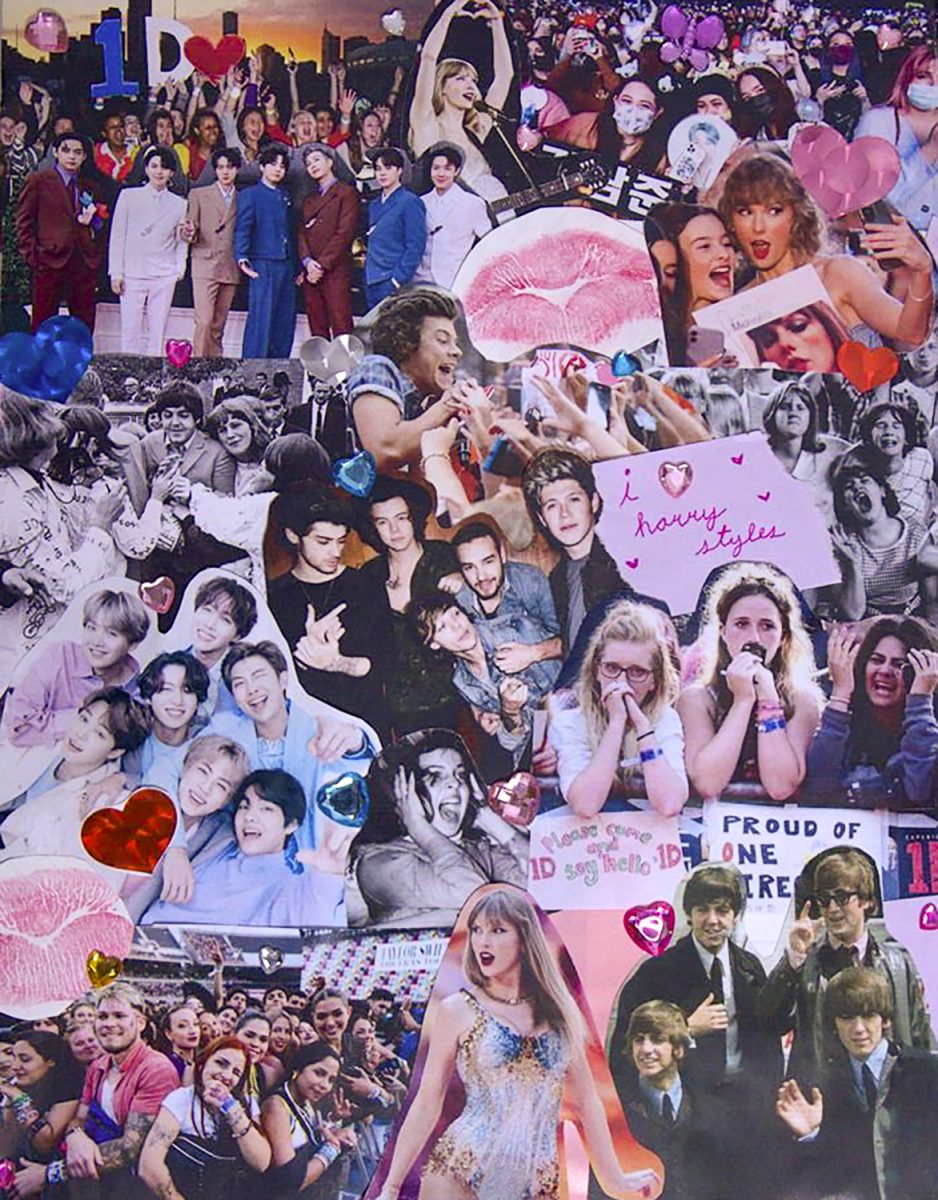Fourth place winner for magazine opinion article in the Journalism Association of Community Colleges 2025 SoCal Publication Awards at the Associated Collegiate Press Spring 2025 Conference in Long Beach, California.
Colorful confetti dances in the air as the closing lyrics to Taylor Swift’s “Karma” sound through the packed stadium of over 70,000 people. From the very front of the pit to the highest point of the nosebleeds, Swift fans of all ages are dressed to the nines—chanting, crying, screaming, laughing—or maybe even a combination of all four. As they dance the night away with their loved ones, all they can think is: this is what life’s worth living for.
With 52 stadium concerts across five continents, and 44 songs from 11 albums performed all within the span of three hours, “The Eras Tour” has forever cemented itself as a key moment in pop culture history. As the final months of 2024 roll in and Swift’s iconic “The Eras Tour” comes to a bittersweet conclusion, the world tour has led to major shifts in the dynamics of fan culture as we know it.
Only a few artists have been able to achieve such lasting fame the way that Swift has—think The Beatles, One Direction and BTS. These artists have all gained worldwide acclaim for their musical talents—but it is their predominantly young female fanbases, who are essential to their success, that are often the target of online criticism. Merriam-Webster defines fangirl as “a girl or woman who is an extremely or overly enthusiastic fan of someone or something.” The very definition of fangirl characterizes these young girls’ enthusiasm as something that can only be in excess. This negative characterization reflects a larger culture of how society perceives young girls and their interests. Fangirls are the true backbone of the music industry and have been even before their sobbing, elated faces came across our digital screens every day.

In the ’60s, the English rock band The Beatles were a household name across Europe, and soon their success transferred to the U.S. In 1964, John Lennon, George Harrison, Paul McCartney and Ringo Starr arrived in New York to perform on “The Ed Sullivan Show.” During their performance, 73 million people tuned in to watch the band play. A mix of rock ’n’ roll with classical music and traditional pop elements were the background for their unforgettable songs. Throughout the performance, a chorus of screams from fangirls in the audience can be heard—sometimes even overpowering the vocals of the song.
Beatlemania had officially swept the nation. The term was first coined by the British media and was later used by American news outlets to describe the band’s passionate female audience.
While The Beatles skyrocketed to fame, these fangirls were often shamed for their passions and their open desire for the four singers. In Tonya Anderson’s doctoral thesis, “Still Kissing Their Posters Goodnight: Lifelong Pop Music Fandom,” she writes how these declarations of passion were actually revolutionary for the women’s movement. Female sexuality was a taboo subject in the ’60s—young girls were shaped into a mold of purity and were not expected to voice their sexual desires. Beatlemania was one of the first times in popular media where young girls unabashedly and publicly expressed their attractions.
“Young women began to assert their sexuality through the consumption of popular music, a practice that for years had been largely the domain of their brothers,” Anderson writes. “This shift in behavior was seen as threatening to a society where the dominant philosophy was, and still is, very much rooted in patriarchal ideologies.”
Jessica Dyer, a lecturer at the British and Irish Modern Music Institute in Bristol, England, and co-host of The Fan GRRRLS Podcast, says fangirl culture is ridiculed because it’s oversexualized. “But that actually teaches us a lot about society and how women aren’t taught or given the space to have sexualized thoughts and build up that type of intimacy and learn about their sexual identity,” Dyer says. “And fandom has really accommodated that.”
As the 21st century rolled in, fangirl behavior was a more common sight in the media. Young girls in the 2010s had moved on to a new set of British heartthrobs.
In 2010, Harry Styles, Liam Payne, Niall Horan, Zayn Malik and Louis Tomlinson auditioned as soloists for the British music competition television show, X Factor, and eventually formed the iconic group, One Direction. Despite not winning the season of The X Factor, they quickly stole the hearts of everyone watching at home and landed a record deal with their debut single “What Makes You Beautiful” setting the record for the highest number of pre-orders for a Sony Music Entertainment single—an impressive feat as the label included artists like Beyoncé and Micheal Jackson.
More than a decade later, One Direction is still recognized as one of the highest selling boybands of all time with a total of 70 million records sold worldwide.
Many of the 70 million records were bought by a new generation of fangirls. Those crying, sexually open girls who swarmed The Beatles concerts became a community of online fangirls making Instagram fan pages, writing fanfiction and virtually interacting with other fans. It was their devotion that helped rocket One Direction to stardom, but a dark side to fan obsession emerged as well.
Fans often theorized that certain members of the band were in secret relationships with one another—the most famous ship being “Larry Stylinson” (Louis Tomlinson and Harry Styles). Fans saw that the two singers were often physically affectionate with one another and interpreted it as a romance that was intentionally kept secret by the band’s management out of fear of it affecting the carefully curated image of attractive young heartthrobs.
Uncomfortable with the constant surveillance on their interactions, Styles and Tomlinson have both denied these rumors online for years and claimed that it negatively affected their friendship. These conspiracy theories are still widely circulated—members of the band, their family and significant others are often harassed and bullied online.
This type of harassment is an example of an unhealthy parasocial relationship. A parasocial relationship is a one-sided relationship where a person feels a strong emotional bond with someone who they do not actually know, often a celebrity.
While not every fangirl envisions herself in a parasocial relationship, Dyer explains how these can deteriorate the foundation of fangirl culture.
“There’s also this sense of there’s no longevity for female fandoms. If we think about football, the metal community—they’re male dominated. They’ve had a really long history of building communities and learning traditions and behaviors associated with that fandom, which means they learn how to interact with celebrities and the object of affection within their fandom,” says Dyer. “Whereas when we look at female fandoms, they’re really short lived and usually based upon popular culture trends, so then they don’t actually have a long history at all.”

While some critiques of fangirls may be valid, these criticisms often have deeper implications about how society perceives young women. Young girls are so often taught to be embarrassed about their interests, and their interests in pop culture are trivialized.
“As long as you have a patriarchal system where things are dictated based off of what men and boys might like, you’re always going to have that dynamic happening,” says Adrienne Trier-Bieniek, a professor of sociology at Valencia College in Orlando, Florida, and author of multiple books on gender, media and pop culture.
Despite the media’s negative portrayal of fangirls, the tides are changing within the fandoms themselves. Modern fandoms today are not deterred from expressing their passion. Fangirls are a force to be reckoned with—and not just in online spaces.
One of the most active fandoms on the internet today is BTS fans. The Korean pop group made up of Jin, Suga, J-Hope, RM, Jimin, V and Jungkook debuted in 2013 and eventually grew to fame in the U.S. in 2017 after their single “DNA” became the first Korean song to make the top 10 of the Billboard 200 charts. BTS and K-Pop fans on social media, specifically Twitter, can sometimes be ruthless, but when they unite their strengths, they are almost unstoppable on a national level.
In 2020, as former president Donald Trump got ready to return to the re-election campaign trail, K-Pop fans on social media platforms encouraged others to reserve tickets to Trump’s Oklahoma rally, which was free, but not attend the event. These videos were widely circulated on Twitter and TikTok: one video encouraging fans to disrupt the rally accumulated over 300,000 views. On the day of the rally, the venue did not even reach its 19,000-person capacity.
Taylor Swift fans, or Swifties, have also played their role in political affairs. In 2022, when tickets for “The Eras Tour” went on pre-sale, the website Ticketmaster crashed, leaving millions of fans in a frozen queue or completely logged out after hours of waiting.
Nearly 2.4 million tickets were sold—breaking the record for most tickets sold in a single day by an artist—but just two days later, Ticketmaster released a statement claiming that because of insufficient ticket inventory and a historically high demand, the general sale for all tour dates would be cancelled.
Swifties were quick to express their contempt for Ticketmaster online. The Ticketmaster fiasco quickly caught the attention of anti-monopoly groups and lawmakers. While a class action lawsuit spearheaded by disappointed Swifties was dropped in 2023, Ticketmaster and its parent company LiveNation, are facing an antitrust lawsuit by the U.S. Department of Justice who allege that the company has been running an “illegal monopoly” as well as using “unfair commercial practices.”
Fangirls have long been the internet’s favorite punching bag, but young girls deserve to have their interests validated. Fangirls have proven the immense power and influence their passions have in the media, changing fan culture every few years.
While Dyer enjoyed growing up in fandoms that were often male dominated, like the metal and rock community, she felt her interest in pop music was often ridiculed and shamed in these spaces. Dyer was able to reclaim her own power as a fangirl by creating The Fan GRRLS Podcast. Her advice for other fangirls out there? It’s simply not caring and being unafraid to embrace your interests and passions.
“This is the feeling it gives me, that has a lot of power. It has incredible power for other women and how we can connect with one another,” Dyer says. “It just has so much joy for so many of us. Why would we cover that?”
Taken from the Winter 2024 print issue of Inside Fullerton. Read it here.




